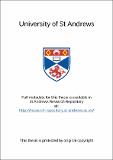Files in this item
Dissipation in the helium II film
Item metadata
| dc.contributor.advisor | Allen, J. F. | en |
| dc.contributor.author | Miller, Daniel B. | en |
| dc.coverage.spatial | 149 p | en |
| dc.date.accessioned | 2021-04-08T09:04:20Z | |
| dc.date.available | 2021-04-08T09:04:20Z | |
| dc.date.issued | 1980 | |
| dc.identifier.uri | https://hdl.handle.net/10023/22022 | |
| dc.description.abstract | The theories that have been presented to explain the properties of liquid helium are reviewed. The existence of vortex lines and their importance to the dissipation in helium II are emphasised leading to a summary of the theories on dissipation in helium II. Attention is paid to the thermal fluctuation theories and to the resulting radical shift of emphasis on the idea of a critical superfluid velocity. The experimental results of measurements in narrow channels are abstracted and it is shown that support for the theories on vortex line equilibrium has been found and that the ideas from the thermal fluctuation theories can be validated. The properties of the helium II film are summarized; observed changes in flow rates, inertial oscillations occurring via film flow and the application of dissipation theories to film flow are discussed. The experimental system is described. The film flow monitored was initiated through the initial run-in to equilibrium and through changing the chemical potential difference across the experimental beaker by applying a time-dependent voltage across one of the two capacitors that formed the liquid helium reservoirs. A detailed analysis of the accuracy of the experimental results is given. The measured inertial oscillations were found to be in agreement with theoretical predictions. The flow rates were dominated by flow steps. No pattern in these steps was evident; there was a peak in their distribution at a superfluid velocity of ~25 cm sec⁻¹ and no evidence for either a critical superfluid velocity or forbidden flow rates. No evidence was found to support dissipative functions of the forms dv/dt α f exp(-vb/v) or dv/dt α (v-vₒ)^3/2. Restricting the data to those when the velocity was a monotonic function of the driving force, supported Langer and Reppy’s proposal that vortex lines parallel to the free surface are the dissipative mechanism in helium II film flow. It is suggested that the very small volume of the annular cylinder formed by the helium film in the region of the beaker where dissipation was dominant may account for the difference between these results and those reported by other researchers. | en |
| dc.language.iso | en | en |
| dc.publisher | University of St Andrews | en |
| dc.subject.lcc | QC183.H3M5 | |
| dc.subject.lcsh | Liquid helium | en |
| dc.subject.lcsh | Superfluidity | en |
| dc.title | Dissipation in the helium II film | en |
| dc.type | Thesis | en |
| dc.type.qualificationlevel | Doctoral | en |
| dc.type.qualificationname | MSc Master of Science | en |
| dc.publisher.institution | The University of St Andrews | en |
This item appears in the following Collection(s)
Items in the St Andrews Research Repository are protected by copyright, with all rights reserved, unless otherwise indicated.

